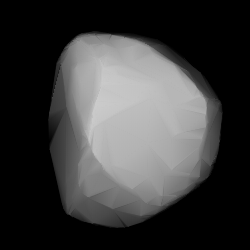Top Qs
Timeline
Chat
Perspective
150 Nuwa
Main-belt asteroid From Wikipedia, the free encyclopedia
Remove ads
150 Nuwa is a large main-belt asteroid with an orbital period of 5.15 years. It was discovered by Canadian-American astronomer James Craig Watson on 18 October 1875,[6] and named after Nüwa, the Chinese creator goddess. This object is a candidate member of the Hecuba group of asteroids that orbit near the 2:1 mean-motion resonance with Jupiter.[7] Based upon the spectrum it is classified as a C-type asteroid,[8] which indicates that it is probably composed of primitive carbonaceous chondritic material and the surface is exceedingly dark.
Photometric observations of this asteroid at the Catania Astrophysical Observatory during 1992 and 1993 gave a light curve with a period of 8.140 ± 0.005 hours.[3] In 2004, an additional photometric study was performed at Swilken Brae Observatory in St Andrews, Fife, yielding a probable period of 8.1364 ± 0.0008 hours and a brightness variation of 0.26 ± 0.03 in magnitude.[9] A 2011 study from Organ Mesa Observatory in Las Cruces, New Mexico gave a period of 8.1347 ± 0.0001 hours with a brightness variation of 0.17 ± 0.02 magnitude, which is consistent with prior results.[4]
On 17 December 1999, a star was occulted by Nuwa.[citation needed]
Remove ads
References
External links
Wikiwand - on
Seamless Wikipedia browsing. On steroids.
Remove ads

